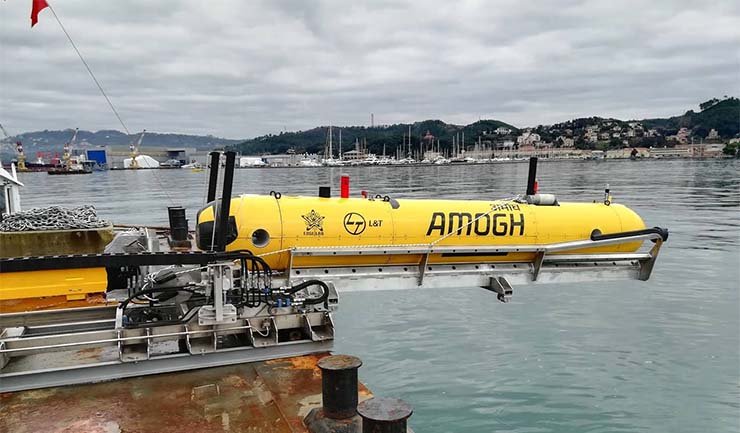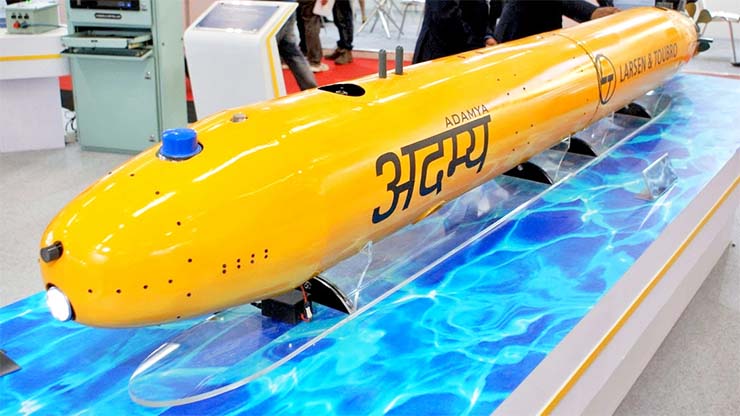
In 1890 in his book The Influence of Sea Power upon History, Alfred T Mahan argued the importance of sea power and made deliberate attempts to advocate controlling the world sea-lanes. His dictum, ‘Whosoever rules the waves rules the world’, still holds relevance. Ruling the sea is becoming challenging, and these challenges will increase with time. Neither aircraft carriers nor nuclear submarines will dominate the sea, but the Unmanned Underwater Vehicle (UUV) will determine the fate of the navies at sea. Those who possess cutting-edge UUV technology and master deploying these UUVs will dominate the oceans.
The Spanish and British empires in the late 1880s dominated the world with their Armadas; the Nazis did with their famous U-Boats, and US with their aircraft carriers. Now, it’s time for the UUV.
What is a UUV?
UUVs are autonomous and semi-autonomous platforms-based invincible weapons designed to rule the sea and the world. The critical element that makes a UUV invincible is the element of surprise. Surprise, as always will continue to be, the vital and foremost principle of war. Though the aircraft carrier gives the navy the advantage to operate anywhere in the world, the UUV will decide the fate of the naval battlefield in the latter half of the 21st century. UUV, coupled with Artificial Intelligence (AI), is the weapon to reckon with.
The autonomous navigation system advancements and machine learning make these platforms more lethal and potent. Another aspect is of ‘UUV Swarms’ and developing operation, navigation, positioning, formation control, path planning, and mission planning capabilities for these swarms.
Swarming drones are numerous, small, lightweight, and networked together to function like bees and can cause immense damage to the enemy submarines and aircraft carriers. Further, these cost effective underwater swarming platforms can prove to be an existential threat to the costly submarines.
The smaller the UUV, greater the lethality component. The reason; first, the tiny size means minuscule configuration and low level of detectability. Second, the cost of killing UUVs seems relatively high considering the size factor, and in contrast, swarm UUVs can cause massive damage to the enemy fleet in a short time.
However, the challenges with UUVs are maintaining the communication network and developing longer underwater endurance. At the more extended range, the water attenuates the waves crucial to keep the communication. The exploration of quantum communication networks for underwater devices is something to work on.
Also, the endurance of UUVs is another challenge, and the submerged endurance of more than 15 days is crucial and critical for underwater military operations and surveillance sustainability.
Further, other variables like ocean currents, underwater obstacles, giant fishes, and fishing nets can affect the mission; thereby, the UUVs equipped with advanced sensors, cutting-edge guidance, a control system, and an on-board brain to collect and decimate relevant data become crucial.
Besides adhering to surprise, these UUVs are attuning to other principles of war, i.e., sustainability and economy of effort, which give them credibility and provide reliability to the navy. Navies worldwide are putting significant efforts into incorporating autonomous and semi-autonomous UUVs in their arsenal. Additionally, with nuclear power UUVs, the future of war at sea will alter.
Global UUV Scenario
China seems to be taking the lead in this sector, Lin Yang, the director of a classified programme at the Shenyang Institute of Automation in Shenyang, China, in 2018, said that his country has plans to develop AI-driven unmanned underwater robots under project 912. The ambition is to dominate the South China Sea and reduce U.S. naval dominance globally.
China, the master of deception, is innovating and deploying UUVs for civilian purposes also. However, the larger aim is to gain a military advantage. China’s advantage in UUVs can be seen from the discovery of a ‘Chinese-origin’ autonomous underwater glider in Indonesian waters and the Indian Ocean.
The deployment of a fleet of underwater drones known as Sea Wing (Haiyi) gliders in the Indian Ocean has enormous strategic and geopolitical implications. The strategy to deploy these dual-use vehicles provides a dual advantage to China in the Indian Ocean Region. First, to map aquatic resources and monitor trade flow, and second to take military advantage when required.

Shenyang Institute of Automation, China’s Shipbuilding Industry Cooperation, and Harbin Engineering University are China’s critical undersea vehicle developers. However, there are a growing number of research institutes and private enterprises in China’s AUV and UUVs market, too.
The document published in 2019 by the Chinese Society of Naval Architecture lists 159 undersea vehicle research projects under development. On the other hand, the U.S. is increasing its funding for the autonomous platform, and the 2020 Pentagon budget reflects the same.
India’s UUV Capability
India’s advancement in the development of UUVs is at a nascent stage and requires a holistic and inclusive approach from all the stakeholders. Recently, to develop and build UUVs, Larsen & Toubro signed a memorandum of understanding with Bengaluru-based New Space Research & Technology, that too only for surveillance purposes.
Also, L&T has showcased its Adamya, Amogh & the Maya AUV at the Defence Expo. The Adamya AUV can be launched from a submarine’s 533 mm torpedo tubes, having operational endurance of more than eight hours. Further, the Defence Research and Development Organisation (DRDO) has developed flat-fished shaped UUVs, which are pre-programmed with algorithms and mission requirements. But, not only the progress, the approach also needs to be faster.
Thereby, India must push to move beyond surveillance. China’s deep bed survey capabilities, which it refers to as ‘ocean battle space environment,’ are the projection of its civil-military capabilities. China, with its UUVs, has mapped the deep-water worldwide, while India’s capability is traditional and requires thrust.
The current maritime security landscape demands the capacity and capability to deploy UUVs. India’s capability to deter the incoming threat at sea will be determined by its action plan for UUVs and AUVs. Also, it is believed that the deployment of UUVs will cut down the cost incurred on the minesweepers. With the enhanced sensors, communications, cyber-security tools, and attack capability, the UUV will prove to be the Varun Astra for the Indian navy.
Apart from this, New Delhi must remember that diplomatic channels work efficiently only from the position of power. Power comes from capability, and foreseeing the future and putting those predictions into action can earn capability.
China’s surveillance activities in the IOR are increasing rapidly, and the deployment of UUVs poses a massive challenge to India’s dominance and affects its diplomatic relations with the key partners in the region. The solution to these lies with developing India’s UUV, i.e. the Varun Astra.
-The writer is an Assistant Professor at Rashtriya Raksha University, Gandhinagar and visiting fellow at NIICE, Nepal. He previously worked as Research Assistant and officiating Web Manager cum Researcher at the Centre for Land Warfare Studies, Indian Army think tank, New Delhi.








